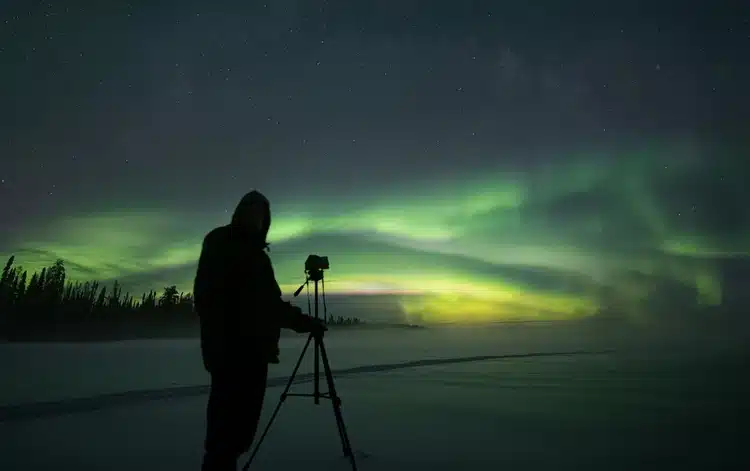Choosing your first telescope is a big deal, folks. It’s like picking out your first car or your first home – okay, maybe not quite that big, but for us stargazing enthusiasts, it’s pretty darn close! Get it right, and you’ll be embarking on a lifetime of cosmic adventures. Get it wrong, and well… let’s just say I’ve seen more than a few telescopes gather dust in garages.

In this guide, we’re going to navigate the sometimes confusing world of telescopes together. We’ll cover everything from the basic types to key specifications. So, grab a cup of coffee (or hot chocolate if you’re underage), and let’s dive into the universe of telescopes!
Table of Contents
Understanding Telescope Basics
Alright, let’s start with the fundamentals. Understanding these basics is like learning the ABCs of astronomy. Trust me, this knowledge will save you from some facepalm moments later on!
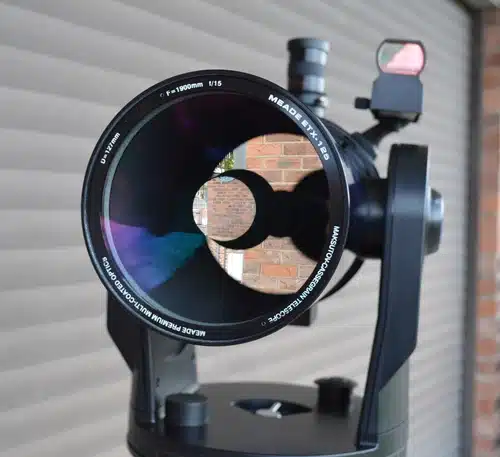
Types of Telescopes
First things first, let’s talk about the three main types of telescopes:
- Refractors: These are what most people think of when they hear “telescope.” They use lenses to gather and focus light.
- Reflectors: These bad boys use mirrors instead of lenses. They’re usually cheaper for their size, but require a bit more maintenance.
- Catadioptrics (compound telescopes): These are like the Swiss Army knives of telescopes, using both mirrors and lenses. They’re versatile but can be pricier.
Each type has its pros and cons, and the best choice depends on what you want to observe and your budget. Don’t worry, we’ll get into that later!
Key Telescope Specifications
Now, let’s decode some of the jargon you’ll see on telescope boxes. Don’t worry if it sounds like Greek at first, you can take a look at this Astronomy terminology any time.
- Aperture: This is the diameter of the main lens or mirror. Bigger is generally better – it’s like having bigger eyes to see faint objects. This may be fine for viewing the Moon, but for viewing galaxies it can be like trying to see a firefly from a kilometer away.
- Focal length: This affects magnification and field of view. Longer focal lengths are great for planets, shorter ones for wide-field views of the Milky Way.
- Magnification: Here’s a surprise – contrary to what you might think, super high magnification isn’t always better. The key is to match the magnification to the telescope’s capabilities and the observing conditions.
Understanding these specs will help you make an informed decision and avoid ending up with a telescope that doesn’t meet your needs.
Remember, choosing your first telescope is just the beginning of your journey. It’s not about having the biggest or most expensive equipment – it’s about finding the right tool to spark your passion for the stars. So, let’s keep exploring and find the perfect telescope for you!
Factors to Consider When Choosing Your First Telescope

Alright, now that we’ve got the basics down, let’s talk about what really matters when you’re picking out your first telescope. It’s not just about the specs – there’s a whole universe of factors to consider!
Budget Considerations
Price ranges for beginner telescopes:
- Entry-level: $100-$300
- Mid-range: $300-$700
- High-end beginner: $700-$1500
Balancing cost and quality is key. Sure, you could go for the cheapest option, but you might end up with the astronomical equivalent of a toy magnifying glass. On the flip side, you don’t need to remortgage your house for your first scope.
My advice? Aim for the middle ground. Remember, the best telescope is the one you’ll actually use!
Portability and Storage

Weight and size considerations are crucial. If you live in an apartment or plan to travel with your scope, consider a more portable option. But if you have a backyard and don’t mind a bit of heavy lifting, a larger telescope can show you more.
Ease of setup and breakdown is another biggie. Trust me, you don’t want to spend an hour setting up your telescope every time you want to use it.
My sweet spot? A telescope I can set up in about 15 minutes. It’s just enough time to get excited about the night ahead, but not so long that I lose interest.
Your Observing Goals

What do you want to see? This is the million-dollar question!
Planetary vs. deep-sky viewing is a key consideration. Some telescopes excel at showing planetary details, while others are better for faint, fuzzy objects like galaxies and nebulae.
I started out obsessed with planets. But then I saw the Andromeda Galaxy for the first time, and suddenly I was all about deep-sky objects. Your interests might change too, so consider a versatile first telescope.
And what about astrophotography aspirations? If you’re dreaming of taking stunning photos of the cosmos, you’ll need to factor that in. Astrophotography requires different features than visual observing.
Remember, it’s okay if you’re not sure about your long-term goals yet. Many beginners start with a good all-around telescope and figure out their preferences as they go. The important thing is to get out there and start exploring the night sky!
So, whether you’re a future planet-spotter, a deep-sky detective, or an aspiring astrophotographer, there’s a perfect first telescope out there for you. Keep these factors in mind, and you’ll be well on your way to making an informed choice.
Popular Telescope Mounts
Alright, stargazers, let’s talk about something that often gets overlooked but is absolutely crucial – telescope mounts. Trust me, a great telescope on a lousy mount is like trying to do brain surgery on a rollercoaster!
Alt-Azimuth Mounts
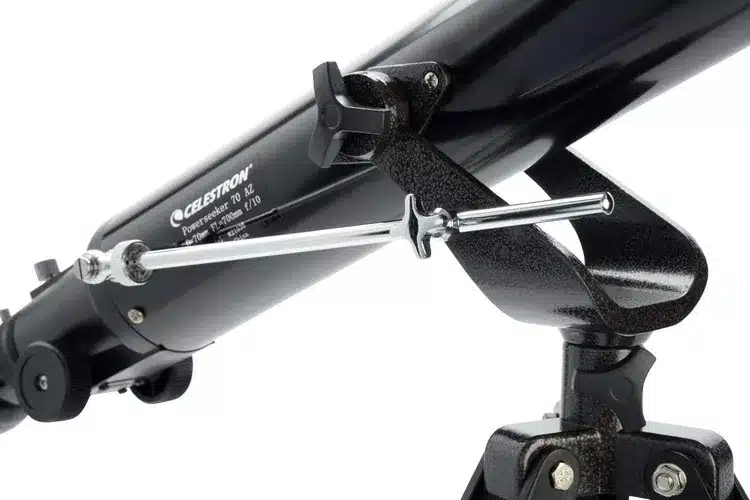
First up, we have the Alt-Azimuth mount, the friendly neighborhood mount of the telescope world.
Simplicity and ease of use are the hallmarks of Alt-Az mounts. They move up-down (altitude) and left-right (azimuth), just like your head does. I love using Alt-Az mounts for quick observing sessions. They’re perfect for those “Oh look, the sky is clear!” moments.
Best applications for Alt-Az mounts:
- Casual observing
- Quick setup and takedown
- Great for beginners
I remember using an Alt-Az mount for the first time. It was so intuitive, I felt like a natural! No star charts, no polar alignment – just point and view. It was like the telescope equivalent of point-and-shoot cameras.
Equatorial Mounts

Now, let’s get a bit fancier with Equatorial mounts. These bad boys align with Earth’s rotation, making it easier to track celestial objects as they move across the sky.
Tracking celestial objects is where Equatorial mounts shine. Once aligned, you can follow a star or planet by adjusting just one axis. It’s like having a cruise control!
But here’s the kicker – there’s a learning curve. I remember the first time I tried to set up an Equatorial mount. Let’s just say it involved a lot of head-scratching.
Learning curve considerations:
- Takes practice to set up correctly
- Requires understanding of celestial movement
- Essential for long-exposure astrophotography
Despite the initial frustration, once I got the hang of it, my Equatorial mount opened up a whole new world of observing. Suddenly, I could keep objects in view for extended periods. It was like the difference between glimpsing a shooting star and watching a whole meteor shower!
Essential Accessories for Your First Telescope
Now that we’ve got the telescope and mount sorted, let’s talk about the supporting cast – the accessories that can take your stargazing from “meh” to “wow!”
Eyepieces
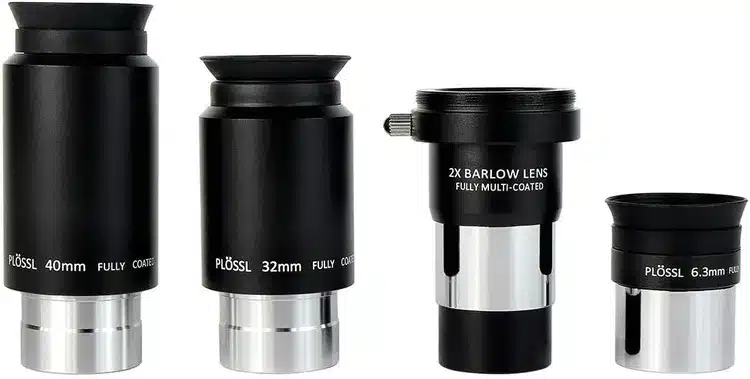
Eyepieces are like the zoom lenses for your telescope. They determine your magnification and field of view.
Understanding eyepiece basics:
- Focal length: Shorter focal length = higher magnification
- Eye relief: Important if you wear glasses
- Field of view: How much sky you can see at once
Recommended starter set:
- Low power (25mm or 32mm): Great for wide views and finding objects
- Medium power (15mm or 10mm): Good all-around eyepiece
- High power (6mm or 4mm): For planetary detail on steady nights
My advice: Don’t go eyepiece crazy at first. I once bought a whole set of expensive eyepieces before I even knew how to use them properly. Start with a couple and expand as you learn.
Finder Scopes
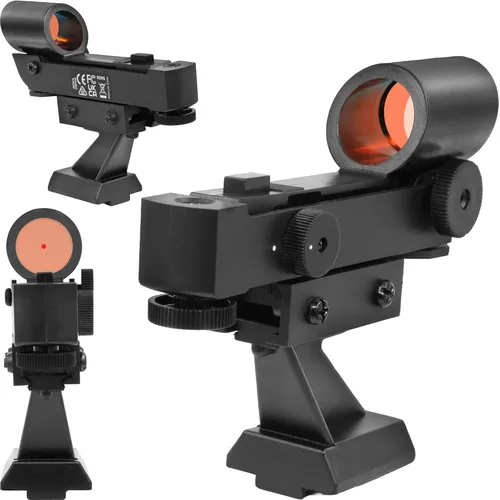
Ah, finder scopes – the unsung heroes of astronomy. These little guys help you locate objects in the sky.
Types of finder scopes:
- Red dot finders: Simple, battery-powered sights
- Optical finders: Mini telescopes with crosshairs
- Telrad finders: Project a bullseye pattern onto the sky
The importance of finder scopes can’t be overstated. I can’t tell you how many times I’ve heard newbies (including myself once upon a time) say, “I can’t find anything in my telescope!”
A good finder scope will save you time and frustration. It’s like having a cosmic GPS for your telescope. Trust me, your future self will thank you for investing in a quality finder scope.
Remember, these accessories aren’t just add-ons – they’re essential tools that can greatly enhance your stargazing experience. So when you’re budgeting for your first telescope, don’t forget to factor in a couple of good eyepieces and a reliable finder scope. Your cosmic journey will be so much more enjoyable with the right gear!
Common Mistakes to Avoid When Buying Your First Telescope
Overemphasizing Magnification
Why high magnification isn’t always better:
- Higher magnification means a smaller field of view
- It amplifies atmospheric turbulence
- It often results in dim, blurry images
Understanding useful magnification:
- A general rule: Maximum useful magnification is about 50x the aperture in inches
- For most viewing, you’ll use much lower magnifications
- Steady, clear images are better than big, blurry ones
Trust me, a clear view of Saturn at 100x magnification is way more impressive than a fuzzy blob at 400x. It’s quality over quantity, folks!
Neglecting the Mount
This is like buying a Ferrari and putting it on bicycle wheels. A great telescope on a wobbly mount is a recipe for frustration.
Importance of a stable mount:
- Keeps your view steady
- Makes it easier to track objects
- Crucial for astrophotography
A powerful telescope on a flimsy mount it’s like trying to use binoculars while riding a mechanical bull!
Avoiding shaky views:
- Invest in a sturdy mount
- Consider the total weight of your setup
- Look for mounts with vibration suppression pads
Remember, a mediocre telescope on a great mount will often outperform a great telescope on a lousy mount. Don’t skimp on the mount!
Recommended First Telescopes for Different Budgets
Now, let’s get to the good stuff – actual telescope recommendations! Remember, the best telescope is the one you’ll use regularly.
Budget-Friendly Options (Under $200)
You can find some decent starter scopes in this range. They won’t show you the face of God, but they’ll definitely get you started!
Best value telescopes for beginners:
- Celestron FirstScope: A cute little tabletop Dobsonian
- Meade Infinity 70mm: A classic small refractor
- Orion FunScope: Another tabletop reflector with good optics
Mid-Range Telescopes ($200-$500)
This is the sweet spot for many beginners. You get a significant step up in quality without breaking the bank.
Balancing quality and affordability:
- Celestron AstroMaster 130EQ: A solid Newtonian reflector
- Orion SkyQuest XT6: A classic 6″ Dobsonian
- Sky-Watcher Heritage 130P: A collapsible Dobsonian, great for portability
Premium Starter Telescopes ($500+)
If you’re sure about your commitment to astronomy and have the budget, these scopes can last you for years.
Future-proof options for serious beginners:
- Celestron NexStar 6SE: A computerized Schmidt-Cassegrain
- Orion SkyQuest XT8i: An 8″ Dobsonian with computer assist
- Explore Scientific AR102: A high-quality 4″ refractor
These are serious instruments. Just remember, a fancy telescope doesn’t make you a better astronomer – practice and patience do!
The first time you use a computerized telescope feels like cheating at first, but then you realize it let you spend more time observing and less time hunting for objects. It’s like upgrading from a paper map to GPS!
No matter what your budget is, there’s a telescope out there that can start you on your cosmic journey. The important thing is to get out there and start exploring. Remember, every great astronomer started with that first look through a telescope. Who knows what discoveries await you under the stars?
Where to Buy Your First Telescope

Alright, future stargazers, you’re almost ready to take the plunge! But where should you actually buy your first telescope? Let’s break down your options.
Online Retailers vs. Local Stores
Pros and cons of each option:
Online Retailers:
Pros:
- Often have lower prices
- Wider selection
- Convenience of shopping from home
Cons:
- Can’t physically inspect the telescope
- Shipping can be tricky (and expensive) for large scopes
- Might miss out on hands-on guidance
Local Stores:
Pros:
- Can see and handle the telescope before buying
- Get personalized advice from staff
- Support local businesses
Cons:
- Usually higher prices
- Limited selection
- Might not have specialized astronomy shops nearby
Importance of customer support: This can’t be overstated, especially for beginners. Good customer support can be the difference between a frustrating experience and a magical one.
Used Telescopes: A Viable Option?

Buying used can be a great way to get more telescope for your money. But it’s not without risks.
Benefits of buying used:
- Lower prices
- Might get high-end equipment for less
- Often comes with accessories
Risks of buying used:
- Potential hidden damage
- Outdated technology (especially for computerized scopes)
- Lack of warranty
What to look for in a second-hand telescope:
- Check the optics for scratches or fungus
- Ensure all mechanical parts move smoothly
- Test any electronic features
- Ask about the telescope’s history and usage
Remember, a well-maintained older telescope can often outperform a cheap new one. It’s all about finding that diamond in the rough!
Summing It Up
Whew! We’ve covered a lot of ground, from the basics of telescopes to where to buy them. Let’s recap the key points to consider when choosing your first telescope:
- Understand the different types of telescopes and their strengths
- Consider your budget, but don’t skimp on quality
- Think about portability and ease of use
- Match the telescope to your observing goals
- Don’t forget about the mount and essential accessories
- Avoid common pitfalls like overemphasizing magnification
- Choose a reputable seller with good customer support
Remember, the perfect first telescope is the one that you’ll actually use. Don’t get too caught up in specifications – focus on what will get you out under the stars regularly.
Starting your journey into astronomy is exciting, frustrating, awe-inspiring, and sometimes a bit overwhelming. But trust me, the first time you see a planet’s details or a distant galaxy through your very own telescope, it’ll all be worth it.
So, what are you waiting for? The universe is calling! And hey, I’d love to hear about your experiences in our community. Are you shopping for your first telescope? Or maybe you remember your first scope? Share your stories or questions with us!
Remember, every great astronomer started with that first look through a telescope. Keep observing, keep learning, and keep reaching for the stars. The universe is out there, just waiting for you to explore it!











